 I want this to be good, you two. So take one more look over here to remind yourselves what you're fighting about. 
Last time we read a novel by the globetrotting Ed Lacy, we said afterward we'd travel anywhere with him. In 1961's The Freeloaders, for which you see a beautiful but uncredited cover above, he once again conducts readers to an exotic place—the Côte d'Azur, in the company of a small clan of Americans trying to survive without work visas in and around Nice. Freelance writer Al Cane, the most recent addition to the group, has occasional gigs and makes enough money to live. Ex-boxer/ex-cop/ex-advertising man/constant enigma Charley Martins has savings that keep him in a nice seafront apartment. But painter Gil Fletcher and inveterate schemer Ed Jones struggle daily. The women within the group are diverse. Charley's girlfriend Pascale is young, beautiful, and precocious; Gil's partner Simone is opportunistic and fickle; Ed's girlfriend Daniele is industrious and kind.
Eventually, Gil, desperate to stay in Nice and in need of money for he and Daniele, cooks up a foolproof robbery scheme. But to quote Mickey Rourke in Body Heat, "Any time you try a decent crime, you got fifty ways you're gonna fuck up. If you think of twenty-five of them, then you're a genius." Gil is no genius. The rest of the story deals with the aftermath of the crime on the Nice guys, the unraveling of the mystery of who the mysterious Charley really is, and Al's growing lust toward Pascale. As with other Lacy novels, the flavor is as important as the plot, and he dishes up the South of France (with sides of Italy) in satisfying fashion. There are always a few nits to pick with him. Any time you write a novel there are at least fifty ways to fuck up. Lacy is no genius, but he always entertains. That's travail numéro un.
 Looks like we're dead meat. You know what I want my gravestone to say? “Just like always it was my stupid brother's fault.” 
Author Max Brand, née Frederick Faust, was incredibly prolific for a guy who died early. He produced numerous stories and around a hundred fifty novels, including the source material for film and television's Dr. Kildare, and the 1956 western Brothers on the Trail, which you see here with Robert Stanley cover art. Brand was killed in 1944 at age fifty-one while working as a war correspondent in Italy, but he left quite a literary legacy.
 People get topless, bottomless, legless, headless—anything goes. 
This fun Italian poster, which is uncredited, was created for the monster movie Spiaggia di sangue, which was originally filmed in the U.S. and released as Blood Beach in 1980, before reaching Italy today in 1981. We riffed on it many years ago because it's nothing more than a left coast remix of Jaws on a frayed shoestring budget, not really deserving of a proper review, in our opinion. The producers were even sued by the Jaws franchise for using a catchphrase—Just when you thought it was safe to go back in the water you can’t get to it—just a little too similar to that for the previous year's Jaws 2—Just when you thought it was safe to go back in the water. We said last time that you never really see the monster. Actually, you do, briefly, at the end, in all its papier mâché glory. Total. Letdown. Don't visit Blood Beach. Instead, look at the lobby cards below and call it a day.       
 It's a perfect moment for a bit of inquieti reflection.  
We said we'd get back to Italian illustrator Enzo Nistri, so today we have two posters he painted to promote the drama Sensi inquieti, which premiered in Italy today in 1962. It was originally made in France as Climats, and was known in English as Climates of Love. It starred Marina Vlady, Jean-Pierre Marielle, Emmanuele Riva, and Alexandra Stewart, and is about a married couple tempted to stray when their relationship begins to feel too constraining. It doesn't sound like our thing, so it isn't one we'll watch, but we thought these were particularly nice pieces. We also have the original art without text below, and a zoom so you can see some details of the work. Nistri was a top talent. We'll have more from him later.
 
 Directly off the boat and immediately into trouble.  
We chose the header for this post because there's a movie called White Mischief, which we watched recently, about Brits in Africa, and it has an amusing line where a character surveys the morning and says, “Oh God, not another fucking beautiful day.” The two pieces of Italian promo art above for the set-in-Africa movie Mogambo might make you say, “Oh God, not another fucking beautiful Italian poster.”
These were painted by Ercole Brini, who we've never featured before but who is another of the many virtuosic artists from Italy that toiled for the movie studios. Whenever we think about the sad loss of painted cinematic poster art, the Italians are who come to our minds. We just don't think there's any doubt at this point—they were the best. Not that it's a competition. Amazing posters with interestingly local aesthetic attributes came from everywhere.
We'll try to feature more from Brini later, and if you're curious about Mogambo it's—of course—another movie about Africa turning various white northerners into cynical, shambling husks of their supposedly better former selves. Those husks are Clark Gable, Ava Gardner, and Grace Kelly. It opened in the U.S. in 1953 and premiered in Italy this week in 1954. Have a look here if you want to know more, and maybe here.
 Who'd want to kill a child? On occasion, virtually any parent on the planet, but in this case it's a violent psychopath. 
This poster was painted by the great Enzo Nistri (the brush behind classic promos such as this and this) for the giallo flick Chi l'ha vista morire?, known in English as Who Saw Her Die? It stars former James Bond lead George Lazenby (looking unhealthily thin here because for reasons inexplicable he lost thirty-five pounds for the role) as an American artist in Venice whose young daughter goes missing. He first appeals to the (pro forma ineffectual) police, but the girl turns up floating dead in the Grand Canal.
This brings Lazenby's estranged wife Anita Strindberg to town for the funeral, and soon they're asking questions about a child murder from the previous year, which we the viewers have seen in the opening reel being committed by a woman clad and veiled in black. Lazenby and Strindberg go full sleuth in order to identify and locate this suspected killer, who meanwhile graduates to knocking off adults who might have clues. You may assume co-star and former Bond villain Adolfo Celi has something to do with all this, and he might, but this is a giallo. There's no way to know who's the killer until the final reveal.
The movie's real star may be Venice, where residents once sauntered easily through lanes uncluttered by tour groups and AirBnB renters. You'll see many hidden nooks of the city, beautifully shot by director Aldo Lado and cinematographer Franco Di Giacomo. This type of scenery will come courtesy of AI image generators in the approaching years. After all, why close down St. Mark's Square when you can render it in a computer? Take heart, though—even a computer will never be able to generate Anita Strindberg. Chi l'ha vista morire? premiered in Italy today in 1972.
 Reaching the highest pleasure. 
Time flies. We've always reminded ourselves to get back to the Italian artist who signed his work as Mafé, but seven years passed. Well, we have him today, better late than not at all. Above you see his poster for the French made sex flick Pornoestasi, which starred Erika Cool, Marilyn Guillame, Élisabeth Buré, and Martine Grimaud, and was originally titled Tout est permis, or “everything is allowed.” Mafé created other nice pieces, several of which you can see by clicking his keyword below.
We had a glance at Pornoestasi, and what you get is a typically clumsy xxx production from the era, poorly scripted and shot, in which a couple who run a clothing boutique together are experiencing some doldrums. The man decides he needs time away from the woman, she agrees, and both take the opportunity to experience new partners. The funny part is that “away” means a hotel in the same town. We'd at least go to Antibes or Saint-Tropez. In any case, Pornoestasi is nothing to write home about. It premiered today in 1977.
 The long and short of legwear.  
Polish actress Magda Konopka tries two different styles of leg coverage in these images that first showed up in the Italian magazine Playmen in 1967. Somewhere in the changing room she lost her shirt, but that'll happen. It's happened to us. Konopka is known for such b-movies as Blindman, Robinson and His Tempestuous Slaves, and When Dinosaurs Ruled the Earth (which we've written about to a ridiculous extent), but is probably best remembered for the 1968 thriller Satanik. We haven't watched that, but it's on the list. You can see more Konopka here.
 It's the same old story. Take a trip to the tropics, lose every bit of self control. 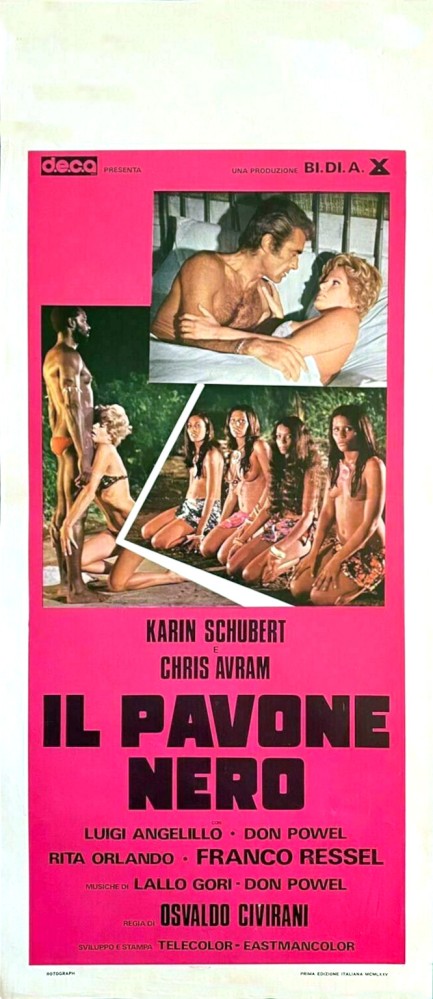
We ran across this Italian locandina for the shot-in-the-Dominican Republic sexploitation flick Il pavone nero, known in English as Voodoo Sexy, and thought it made a nice alternate promo to the one we posted years back. The movie premiered in Italy today in 1975, and with a title like Voodoo Sexy you know what it's about: white skin + tropical heat = a total loss of inhibitions. Flicks of this ilk were an unofficial subgenre of ’70s and ’80s cinema. We love them, and you know why? Because they aren't wildly inaccurate in terms of northerners going crazy down south. The star of this one was German actress Karin Schubert, and that's the other reason we revisited the film—it gave us an excuse to share the photo of her below. Hope it helps you get over hump day. 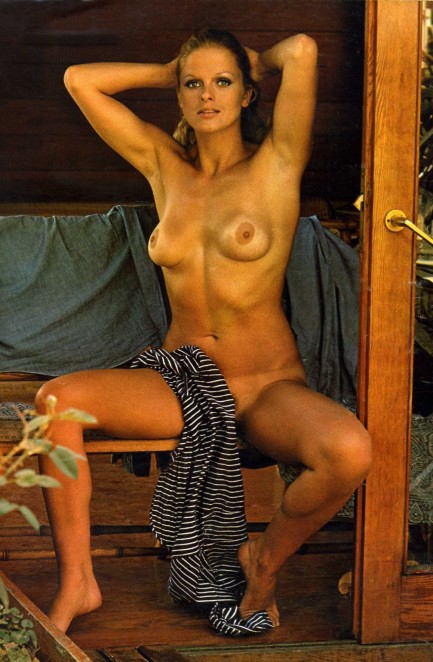
 In the land of the blind the one-eyed woman is queen. 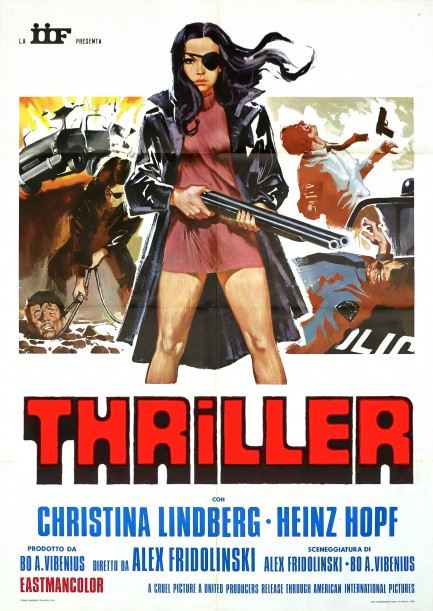 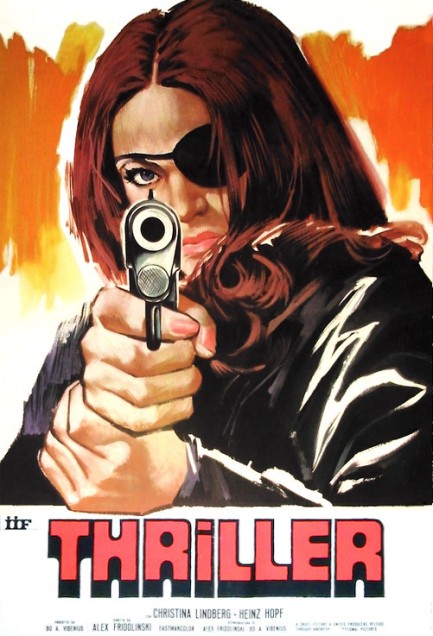 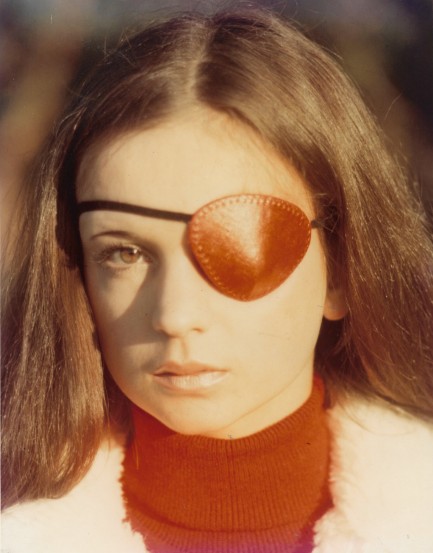
We've done a lot on Sandro Symeoni, which means that just for the sake of completeness we can't overlook these. They're his Italian posters for the Christina Lindberg grindhouse classic Thriller, which was originally made in Sweden as Thriller - en grym film, and in English speaking countries was known as Thriller: A Cruel Picture and They Call Her One Eye. We've already talked about it, and its star.

|
 |

The headlines that mattered yesteryear.
2003—Hope Dies
Film legend Bob Hope dies of pneumonia two months after celebrating his 100th birthday. 1945—Churchill Given the Sack
In spite of admiring Winston Churchill as a great wartime leader, Britons elect
Clement Attlee the nation's new prime minister in a sweeping victory for the Labour Party over the Conservatives. 1952—Evita Peron Dies
Eva Duarte de Peron, aka Evita, wife of the president of the Argentine Republic, dies from cancer at age 33. Evita had brought the working classes into a position of political power never witnessed before, but was hated by the nation's powerful military class. She is lain to rest in Milan, Italy in a secret grave under a nun's name, but is eventually returned to Argentina for reburial beside her husband in 1974. 1943—Mussolini Calls It Quits
Italian dictator Benito Mussolini steps down as head of the armed forces and the government. It soon becomes clear that Il Duce did not relinquish power voluntarily, but was forced to resign after former Fascist colleagues turned against him. He is later installed by Germany as leader of the Italian Social Republic in the north of the country, but is killed by partisans in 1945.
|

|
|

It's easy. We have an uploader that makes it a snap. Use it to submit your art, text, header, and subhead. Your post can be funny, serious, or anything in between, as long as it's vintage pulp. You'll get a byline and experience the fleeting pride of free authorship. We'll edit your post for typos, but the rest is up to you. Click here to give us your best shot.

|
|
























































































































